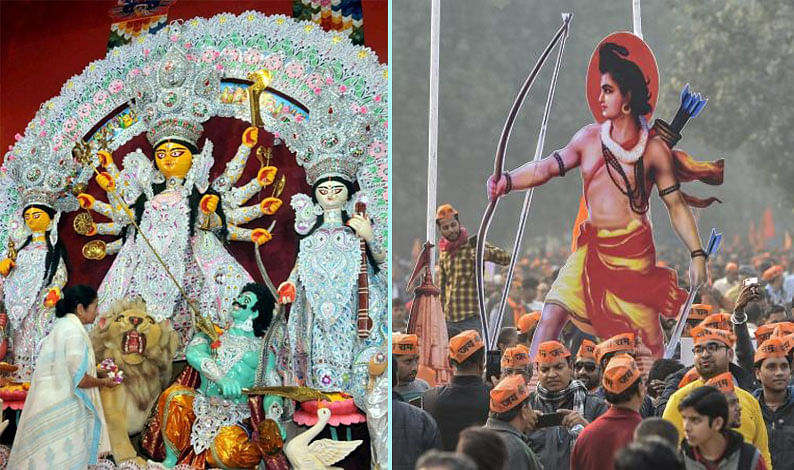
A mishmash of mythology, epic, popular history and religious bigotry is dominating Bengal's political scene, replacing the 'godless' Leftist ideology that had prevailed for long. Now, Ram, Durga, Kali and other fearsome, but lovable gods and goddesses have replaced the equally fearsome, but not-always-so-lovable socialist icons of both Europe and India ‒ particularly Bengal.
Meanwhile, the entry of the Bharatiya Janata Party (BJP) in Bengal, stoking the fire of popular religion with the 'Jai Shriram' slogan, has threatened to spoil the ruling Trinamool’s party. So-called political programmes like celebrating Mahavir Jayanti to popularising the might of Hanuman, to building sun temples, have become common in the state. For, the BJP is 'Indianising' Bengal and fast gaining ground.
But the Trinamool Congress (TMC), as the most prominent rival of the saffron party in Bengal, cannot afford to allow the BJP to steal the show. The TMC, instead has rediscovered Bengali sub-nationalism and reintroduced the 'Jai Bangla' slogan, which has actually been borrowed from the neighbourhood. Also, 'Jai Hind', borrowed from Subhash Chandra Bose, is being used heavily. The aim: To show that we, Bengalis, are not of the mainstream.
What's more, TMC chief, Mamata Banerjee, has also decided to fend off the BJP with the BJP brand of Hindutva ‒ a mishmash of pop history and mythology. Although she never said so in as many words, but Mamata has defied Ram in public several times and invoked the names of Durga and Kali in a bid to strike a chord with the masses.
So, what prompts this battle over the gods? In rural Bengal, Ram, the king of Ayodhya, is a Hindi-speaking ruler of north India. So, he is an aggressor and, at the most, a hero of the epic, Ramayana. But in north India, Ram, Maryada Purushottam, is a role model for his sense of justice and fair play, which were rare among Indian rulers. History verifies that democracy and the rule of law were almost non-existent even among the oligarchic states in ancient India.
The architect of the Indian Constitution, BR Ambedkar, had once famously remarked that India never had any democratic ground rules. So, convincing the people of India to follow the Constitution was a tough job, which was probably the reason why Mahatma Gandhi – perhaps the greatest political dreamer that the world has ever seen – found a model in Ram, and aspired to found a Ramrajya in India.
For the BJP too, since the party made its mark in Indian politics by invoking the name of Ram and laying claim to his birthplace by destroying the Babri mosque in Ayodhya, the 'Jai Shriram' war cry is an all-weather political tool. And Mamata Banerjee knows it. She can't allow Lord Ram, an almost forgotten king of a distant land, to steal the limelight in her state and relegate her to the backstage, to play the second fiddle.
What the TMC chief found ‒ sifting through her experience as a Hindu, born in a Bengali home ‒ were two divinities, Durga and Kali, who could compete with Ram ‒ at least politically. Durga, according to Bengali folklore, is the ubiquitous Bengali daughter. She comes to her parents' home every year during the autumnal Navratra with Shiva, her marijuana-smoking, eccentric husband, her children and hordes of demons who are Shiva's acolytes. Kali, another version of the same goddess, is also a quintessential Bengali woman ‒ fearsome and kind at the same time.
Mamata Banerjee knows that an average Bengali, especially men and women in rural Bengal, will connect better with Durga and Kali than Ram, who was after all, a king and spoke Hindi. This writer, stunned, asked some propagators of this theory at a village gathering in Birbhum district of West Bengal, what made them think that Ram spoke Hindi, a language that historically had not even evolved during the period the Ramayana refers to. Pat came the reply, "Sanskrit is spoken sometimes by Brahmins. Ram was a warrior-king. How would he know Sanskrit?"
It's also a fact that Ram also has a place in the Bengali psyche, but as a worshipper of Durga. Mythology says that he invoked the goddess before going to war with Ravan, the king of Lanka, and to appease the goddess, had offered her his lotus petal-shaped eyes. So, rural Bengal argues that Bengal's daughter, Durga, is clearly superior to north Indian Ram.
One of the most revered poets of Bengal, Michael Madhusudan Dutta, had expressed his sympathies for Ravan and his son Indrajeet in his epic poem, Meghnad Bodh Kavya. In Bengal, Ravan, a rebel, is considered to be an underdog and so, he must be supported. The reason: Before the rise of the Indian National Congress, Bengal had always been against the dominance of mainstream India, which is now essentially Hindi speaking.
But all these arguments do not explain the sudden rise of the 'Jai Shriram' slogan in the state. At last, it seems, rural Bengal has begun to realise that even if the latest avatar of Ram is Hindi-speaking, it has political might and can offer an alternative to the Trinamool Congress. This is no doubt, the reason why Mamata Banerjee finds it increasingly difficult to restrain herself every time she is confronted with the 'Jai Shriram' slogan.
Mamata Banerjee's desperate moves and knee-jerk reactions obviously go against the set rules of political wisdom, but that is the power of BJP's Ram, who now speaks Hindi, or maybe Awadhi, and, it seems, will stop at nothing till he takes his 'rightful' place in Bengal.
(The author has experience across three decades and more, has had leadership roles in the print, television and online media in three metropolises. He writes on politics)
The views expressed above are the author’s own. They do not necessarily reflect the views of DH.